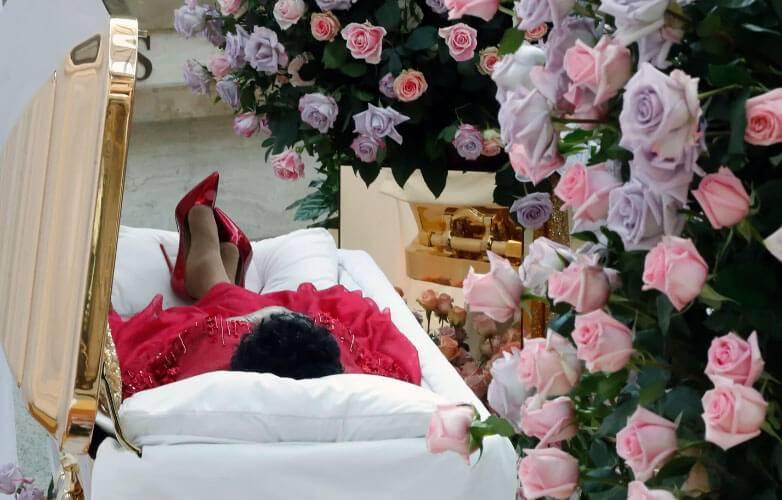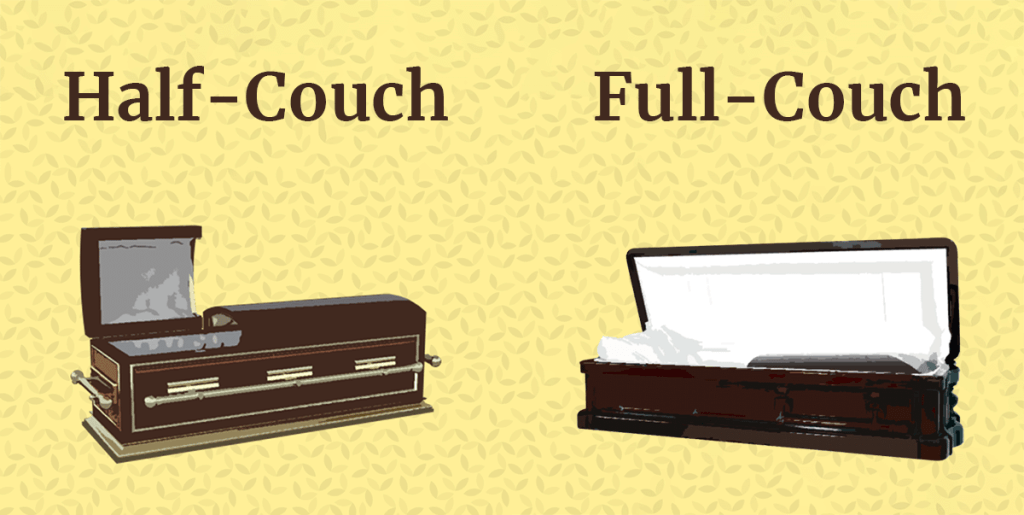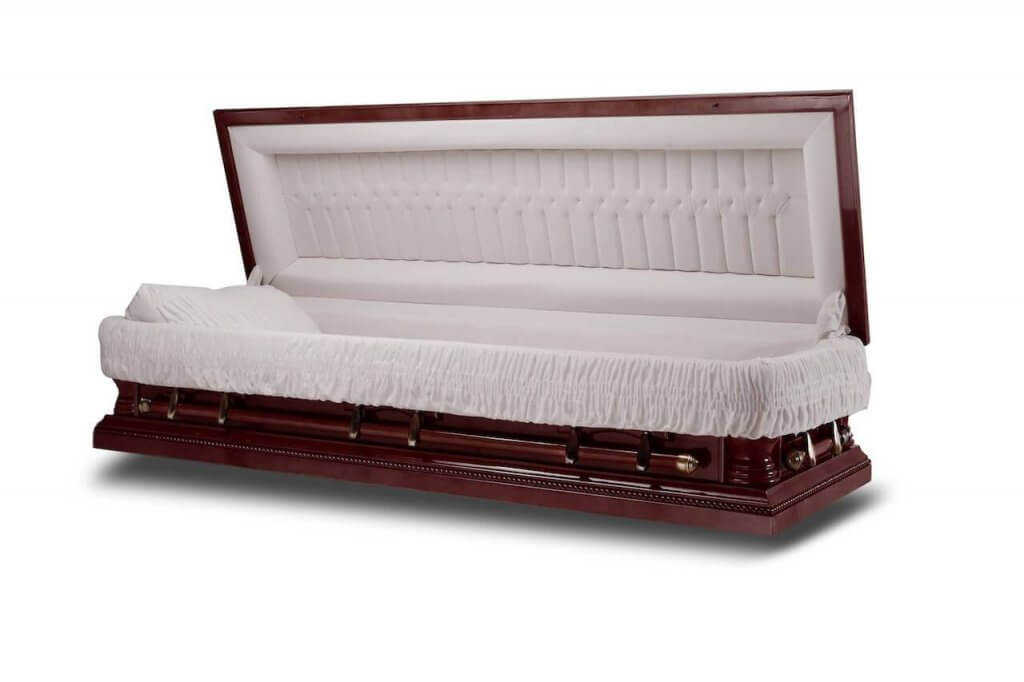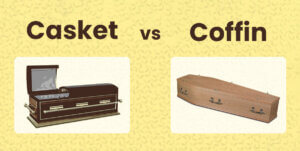I’ve heard many wild claims in my time. One outlandish myth is “they cover legs at funerals because they break them to fit into the caskets!” I assure you there is no merit in this claim.
Typically, legs are covered in a casket because of swelling in the feet that makes fitting shoes difficult. When swelling is not present, the legs may still be covered at a funeral due to cultural preferences, the type of casket used, the size and condition of the body, and aesthetic considerations.
Of course, no two funerals (or bodies) are the same.
In this post, I will explain the many reasons why the deceased body’s legs might be covered in the casket at a funeral service. This will include discussing some of the challenging decisions that morticians must make.
In This Article
9 Reasons Legs Are Covered in Caskets
1. Due to the Condition of the body
When deciding whether to cover the legs, the first question a funeral director will ask themselves is: Are they presentable?
Sometimes legs are damaged because of the cause or death or because the deceased donated skin. In these cases, displaying the legs may be a distraction or reminder of trauma at the funeral service or viewing. Covering them is often the respectful thing to do.
This doesn’t only apply to legs but to other body parts too. Wounded hands or arms would also be covered.
Needless to say, most people don’t die in traumatic accidents. But the question of “presentability” does not only apply only to injuries. It also applies to cases where the “shoe just doesn’t fit” – literally.
A significant number of bodies come in to funeral homes with swollen feet. The chemicals used in the embalming process solidify the swelling, making the body stiffer and the feet hard to bend and manipulate. This is on top of any already present rigor mortis.
It is difficult to fit shoes on stiff and swollen feet, and an otherwise clothed body with no shoes can be jarring. In these cases, the funeral director will usually cover the lower half of the body in the casket. This ensures focus is solely on the deceased person’s face, torso, hands, and humanity.
Whether the body is wearing shoes in a sealed casket depends on whether the funeral director can get them to fit. However, just because the shoes don’t fit doesn’t mean they won’t be buried with the body in its final resting place. Shoes are commonly placed next to or between the feet in the casket instead.
None of this means a funeral director won’t try their best to ensure the body is visibly wearing shoes if you ask. Requests like this from families are common. Most funeral homes will try their best to be accommodating.
A famous example of this type of accommodation are the beautiful red stilettos worn by Aretha Franklin at her viewing in 2018.

2. To Reflect the Humanity of the Deceased
Think about a loved one who has recently passed away. What do you see?
Their facial expressions? Their smile? Their eyes? Their hand gestures?
People rarely place much sentimental value on legs and feet. There may be exceptions, but they’re certainly rare.
Humans express platonic love, affection, communication, and familiarity from the waist up. It is no secret that some of the most profound human connections are developed through the eyes and face. Open-casket funerals are supposed to help people remember their loved ones, touch them, hold their hands, and say their final farewell. This can help with the grieving process.
The feet are rarely a point of primary focus or interaction at a wake. Covering them can help attendees connect with the humanity of the deceased without the distraction of what shoes have been placed on the body (if any).
3. Because of the Type of Casket Used
Generally speaking, there are two types of casket: Half-couch caskets and full-couch caskets. Half-couch caskets are also known as partial-couch or split-couch caskets.

The main difference between half-couch caskets and full-couch caskets is that full-couch caskets are completely open, showing the full body of the deceased, while the lids of half-couch caskets only open partially, showing the torso, arms, hands, and face.
If a person organizing a funeral chooses a half-couch casket, they are choosing to cover the deceased’s legs with the lower half of the casket. A blanket is also usually placed underneath that.
Half-couch caskets are the more frequently chosen option. This helpfully leads us to the following reason why funeral directors cover the legs:
4. To Save on Costs
A reputable funeral home employee will respect a dead person’s entire body. They would quickly be driven out of the industry if they did otherwise.
However, this does not mean that every aspect of a dead body will or should receive the same level of attention. When the legs and feet are covered, the person preparing the body can pay less attention to them.
In a full-couch casket with the lid fully open, the amount of time required to ensure that the lower body looks as well preserved as the face (which requires makeup), hair (which requires styling), and clothes, can add significant unnecessary expense.
With funeral and casket prices rising significantly every year any extra cost can be substantial. Cost effective options are sought after.
It is worth noting that full-couch and half-couch caskets of the same size cost around the same price. There is no real cost saving on the coffin itself, but on the work the funeral director undertakes.
If saving money is a major concern for a deceased’s family, they should consider other options. Alternatives include cremation or direct or natural burial without a casket or coffin at all.
5. Due to Regional Traditions
I called a couple of funeral homes to see if there might be any reasons I was missing.
I managed to get on the phone with a funeral director in my home country, New Zealand. He explained that full-couch caskets showing the legs are normal over here. I confirmed this by looking through the websites of a couple of New Zealand based casket stores. They only sell full-couch options!

After some research, it became clear that a lot of people choosing a casket simply follow tradition. People and churches have passed down regional traditions and practices for many years.
For example, it is traditional to choose a half-couch casket in the southern area of the United States. In contrast, in the UK, full-couch coffins appear to be the preferred option.
6. Due to the Culture and Religion of the Deceased
Different religions and cultures have varied thoughts on covering legs at funerals as well. The table below shows the approach different religions generally take:
| Religion | Legs Covered During Funeral? |
|---|---|
| Christianity | Generally, yes. Depending on the region, most Christian funerals have a half-casket closed at the service with the deceased’s legs covered. The body is often able to be viewed by close friends and family members at a viewing before the funeral service. |
| Islam | Yes. After a Muslim passes away, their body is covered with a shroud. They are usually buried without a coffin or casket for religious reasons. |
| Buddhism | No. Traditional Buddhist “funerals” typically consist of the dead body being placed in an open area with the full body visible. |
| Hinduism | Yes. As part of the antyeshti ritual, most Hindu’s entire dead bodies are wrapped in white cloth after death and cremated shortly after that. |
| Sikhism | Yes. Subject to regional exceptions, most Sikhs have closed casket funerals before they are cremated shortly after death. This includes covering the face. |
7. For Aesthetic and Lighting Reasons
The implications of “presentability” do not only apply to the condition of the body.
Funeral homes spend a lot on ensuring dead bodies are displayed in comforting lighting. Most funeral homes use soft lights placed at special angles. This makes the deceased look calm, rested, and at peace. The aim is to make the body look, to an extent, like it is sleeping.
It is well-known in the funeral industry that half-couch caskets allow for better lighting at a funeral or casket viewing, and give loved ones a better opportunity to see the embalmed body. It is much easier to light the upper half of a body in a comforting way, rather than an entire body.
Even at fully open casket funerals, it is common for a blanket to be placed over the lower body of the deceased to make them look cozy and still.
The decorations that the deceased’s family chose to have at the funeral are also relevant. Placing a heartfelt funeral spray on the casket will not be practical if a full-couch casket is used.

Standing sprays are an option, although I’m not a huge fan of them.
8. Because of the Size of the Body
Tall bodies may not fit into a standard-size casket.
Funeral directors and embalmers never break a person’s legs so they fit in a casket or a coffin. If a body is ever too tall for a standard casket, the mortician will find one that is larger. When this is not possible due to time or budgetary reasons, legs may be slightly bent at the knee joint instead.
To be clear, when I say “bent at the knee joint,” I mean in the same way you might try and fit into a bathtub that is a little too small for you.
If bending the knees doesn’t work, then the funeral director might try to cross the body’s legs to fit in the casket. However, in these cases, an oversized casket is likely to be recommended instead.
There may have been some exceptions to this in the past, but rogue morticians have always been swiftly punished.
Regardless, a body with bent knees does not look comfortable. Given the need to focus on ensuring that the deceased looks peaceful, the legs will usually be covered in these circumstances.
9. Because Funeral Directors Recommend It
Most people calling a funeral director for the first time have no idea where to start. A lot of trust is placed in professionals in the funeral industry.
For all the reasons on this list (and more), it makes sense that many funeral directors would be the first to recommend covered legs in the casket. My suggestion is the person planning the funeral should accept that advice – it has probably been given for a reason.
From the perspective of the funeral director, covering the legs allows them to focus on the parts of the body that are likely to matter the most to the deceased’s loved ones.
From the perspective of the deceased’s family and friends, they will attend a funeral where they can see their deceased loved one in the best possible light.
The Bottom Line
There are many reasons that legs might be covered in caskets, and not all of them are as obvious as the others.
If you are planning a funeral, whether you choose a half-couch or full-couch casket and whether the legs are shown or not is entirely up to you.
My only further suggestion is that you should discuss it with your funeral director in light of what you now know from reading this article.
If you have any further questions about funerals, caskets, or anything beyond life, please feel free to get in touch.










